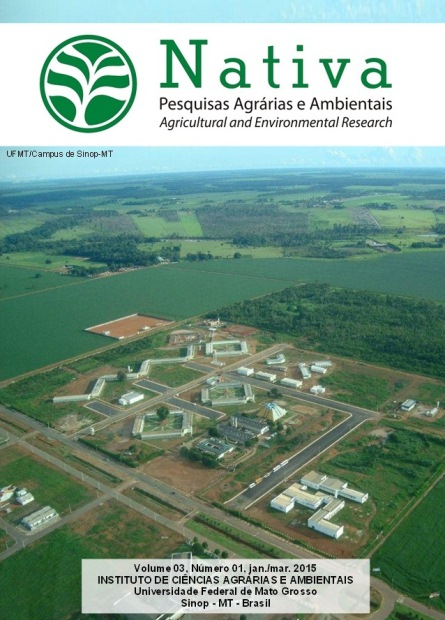PADRÕES ALOMÉTRICOS DA PALMEIRA CARNAÚBA (Copernicia prunifera (MILL.) H.E. MOORE)
DOI:
https://doi.org/10.31413/nativa.v3i1.1808Resumo
Objetivou-se neste estudo caracterizar os padrões alométricos da Copernicia prunifera em região semiárida do Rio Grande do Norte. O levantamento foi realizado em uma área rural do município de Lagoa de Pedras, RN. Foram amostrados todos os indivíduos adultos reprodutivos em uma área de 1,1 hectares, totalizando 33 plantas. As relações alométricas avaliadas foram entre: altura total x altura do fuste, CNS (circunferência ao nível do solo) x altura do fuste, CNS x altura total, CAP (circunferência à altura do peito) x altura do fuste, CAP x altura total, e número de folhas x altura total, foram determinadas por equações obtidas por regressões polinomiais. Em seguida, aplicou-se a correlação de Pearson (rp). A regressão polinomial indicou maior relação entre altura total x altura do fuste (R2 = 0,98). Apenas a relação entre os padrões alométricos altura total x altura do fuste apresentou correlação positiva (rp = 0,989). Os resultados obtidos refletem as estratégias de crescimento e adaptação da palmeira carnaúba no seu ambiente natural.
Palavra-chave: alometria, semiárido, Arecaceae.
ALLOMETRIC PATTERNS OF THE PALM CARNAUBA (Copernicia prunifera (MILL.) H.E. MOORE)
ABSTRACT
The aim of this study was to characterize the allometric patterns of Copernicia prunifera in semi-arid region of Rio Grande do Norte. This research was conducted in a rural area of the Lagoa de Pedras city, RN. We sampled all adult reproductive individuals in an area of 1.1 hectares, with a total of 33 plants. Allometric relationships were evaluated between: total height x height of the bole, CNS (circumference at ground level) x height of the bole, CNS x overall height, CAP (circumference at breast height) x height of the bole, CAP x overall height, and number of leaves x overall height, were determined by equations obtained by polynomial regressions, then applied the Pearson correlation coefficient (rp). Polynomial regression indicated greater relationship between total height x height of the bole (R2=0.98). Only the relationship between allometric patterns overall height x height of the bole showed positive correlation (rp=0.989). The results obtained reflect the growth and adaptation strategies of carnauba palm tree in its natural environment.
Keywords: allometry, Semi-arid, Arecaceae.
Referências
ARCHIBALD, S.; BOND, W. J. Growing tall vs growing wide: tree architecture and allometry of Acacia karroo in forest, savanna, and arid environments. Oikos, Buenos Aires, v.102, n.1, p.3-14, jun. 2003.
BAUERMANN, S. G. et al. Diferenciação polínica de Butia, Euterpe, Geonoma, Syagrus e Thritrinax e implicações paleoecológicas de Arecaceae para o Rio Grande do Sul. Iheringia. Série Botânica, Porto Alegre, v. 65, n.1, p.35-46, jun. 2010.
BEGON, M. et al. Ecologia: de indivíduos a ecossistemas. 4. ed. Porto Alegre: Artimed, 2007. 752p.
BORCHERT, R. et al. Modification of vegetative phenology in a tropical semi-deciduous forest by abnormal drought and rain. Biotropica, Washington, v.34, n.1, p. 27-39, mar. 2002.
CARVALHO, J. N. F. Pobreza e tecnologias sociais no extrativismo da carnaúba. 2008. 100f. Dissertação (Mestrado em Desenvolvimento e Meio Ambiente) – Universidade Federal do Piauí, Teresina, 2008.
D’ALVA, O. A. O extrativismo da carnaúba no Ceará. Fortaleza: Banco do Nordeste do Brasil, 2007. 172p.
HENDERSON, A. et al. Palms of the Americas. Priceton: Princeton University Press, 1995. 352p.
NIKLAS, K. J. et al. Comparison between the record height-to-stem diameter allometries of pachycaulis and leptocaulis species. Annals of Botany, London, v.97, n.1, p.79-83, jan. 2006.
RICH, P. M. Mechanical architecture of arborescent rain forest palms. Principes, Miami, v.30, n.3, p. 117-131, jul./set. 1986.
Downloads
Publicado
Edição
Seção
Como Citar
Licença
Direitos Autorais para artigos publicados nesta revista são do autor, com direitos de primeira publicação para a revista. Em virtude de a aparecerem nesta revista de acesso público, os artigos são de uso gratuito, com atribuições próprias, em aplicações educacionais e não-comerciais.
A artigos publicados nessa revista, podem ser reproduzidos parcialmente ou utilizados como referência por outros autores, desde que seja cita a fonte, ou seja, a Revista Nativa.
Copyright for articles published in this journal are the authors, with first publication rights granted to the journal. The journal shows open access, and articles are free to use, with proper attribution, in educational and non-commercial.
The articles published in this journal may be reproduced in part or used as a reference by other authors, provided that the source is quoted.






